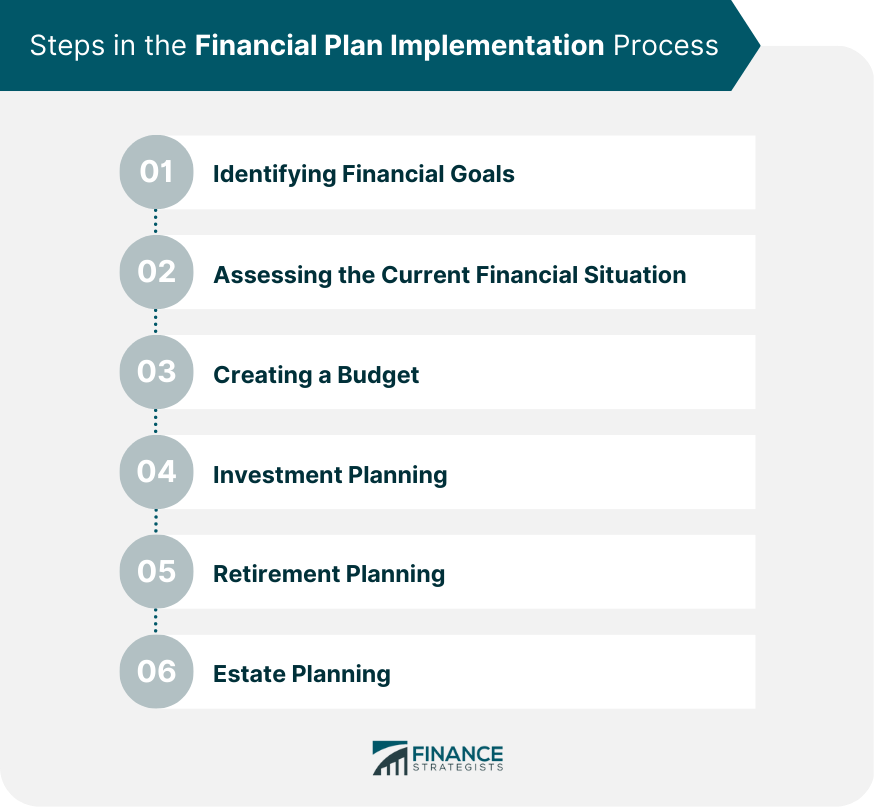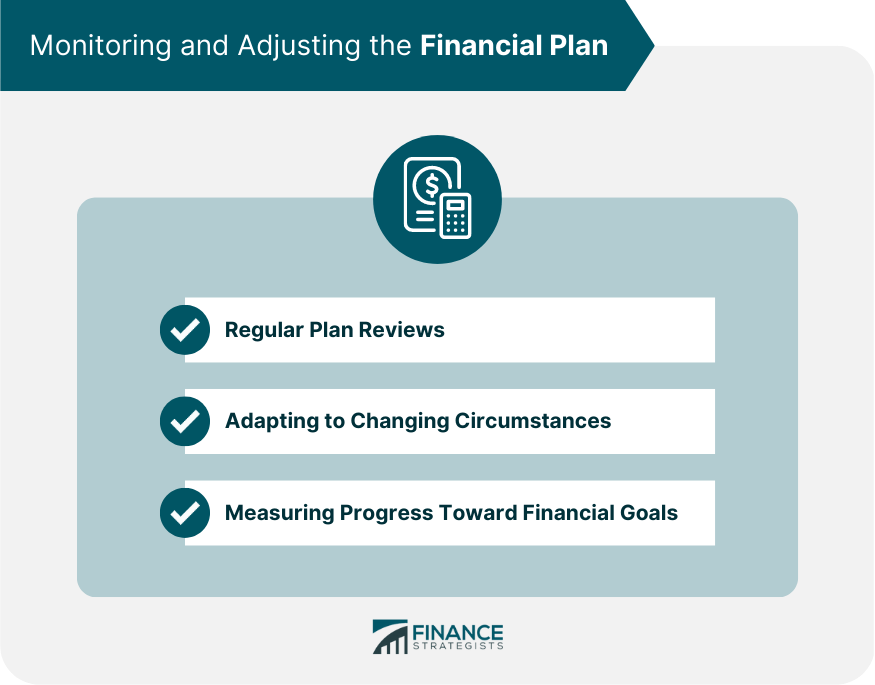Financial plan implementation is the process of putting into action the strategies and steps outlined in a financial plan to achieve specific financial goals. It involves taking concrete steps towards achieving financial objectives, monitoring progress, and adjusting the plan as needed. Financial plan implementation involves executing the action steps outlined in the financial plan. This may include actions such as opening and funding investment accounts, paying off debt, creating a budget, increasing savings, or reducing expenses. It may also involve seeking out professional advice, such as from a financial advisor or tax professional. The implementation process typically requires discipline, focus, and commitment to the long-term goals outlined in the financial plan. By following the plan and taking consistent action, individuals and businesses can improve their financial situation and work towards achieving their financial objectives Short-term financial goals are those you aim to achieve within one year. Examples include building an emergency fund, paying off high-interest debt, or saving for a vacation. Identifying short-term goals can help you establish a strong foundation for financial stability. Medium-term goals are typically achievable within one to five years. These might include saving for a down payment on a house, funding a child's education, or starting a business. Medium-term goals bridge the gap between short-term and long-term financial objectives. Long-term financial goals are those that take more than five years to achieve. Retirement planning, investing in real estate, and building a substantial investment portfolio are common long-term goals. Identifying these goals will guide your overall financial plan. To assess your current financial situation, start by calculating your net worth. This involves subtracting your total liabilities (debts) from your total assets (savings, investments, property). Knowing your net worth can provide a clear picture of your financial health and help you track progress over time. Performing a cash flow analysis involves examining your income and expenses to determine whether you have a positive or negative cash flow. This analysis is essential for identifying areas where you can cut expenses or increase income to improve your financial situation. Managing debt is a crucial aspect of financial plan implementation. Create a debt repayment strategy that prioritizes high-interest debt, such as credit cards, while also considering other obligations like student loans or mortgage payments. Fixed expenses are recurring costs that remain relatively constant, such as rent or mortgage payments, utilities, and insurance premiums. When creating a budget, account for these expenses first to ensure they are covered each month. Variable expenses are those that fluctuate each month, such as groceries, entertainment, and transportation costs. Allocating a portion of your budget for variable expenses allows for flexibility in spending while still maintaining control over your finances. Setting aside a portion of your budget for savings and investments is crucial for achieving long-term financial goals. Establish a regular savings habit and consider investing in a diversified portfolio to grow your wealth over time. Insurance plays a vital role in managing financial risks. Evaluate your insurance needs, including life, health, disability, and property insurance, to ensure that you and your family are protected in case of unexpected events. An emergency fund is a critical component of any financial plan. Aim to save three to six months' worth of living expenses in a readily accessible account to cover unexpected expenses, such as medical emergencies or job loss. Asset allocation involves dividing your investments among different asset classes, such as stocks, bonds, and cash, to balance risk and potential returns. Develop an asset allocation strategy that aligns with your risk tolerance and financial goals. Diversification is the practice of spreading your investments across various assets to minimize risk. By investing in a range of assets, you can reduce the impact of poor performance in a single investment. Tax-efficient investing involves structuring your investments to minimize the impact of taxes on your returns. Consider tax-advantaged accounts, such as IRAs or 401(k)s, and tax-efficient investment products like index funds or municipal bonds to optimize your after-tax returns. Determining how much money you will need for retirement is essential for creating a long-term financial plan. Consider factors such as living expenses, healthcare costs, and desired lifestyle to estimate the amount you will need to save for a comfortable retirement. Develop retirement savings strategies that align with your financial goals and time horizon. Consider employer-sponsored retirement plans, individual retirement accounts (IRAs), and other investment vehicles to build your retirement nest egg. Social Security and pension benefits can provide additional income during retirement. Understand how these benefits work, when you can begin receiving them, and how they will factor into your overall retirement income. Estate planning is essential for ensuring that your assets are distributed according to your wishes upon your death. Creating a will or establishing a trust can provide clear instructions for the distribution of your estate. A power of attorney document grants a designated individual the authority to make financial and legal decisions on your behalf in the event of incapacity. This document is an essential component of a comprehensive estate plan. Ensure that your beneficiary designations on retirement accounts, life insurance policies, and other assets are up to date. These designations determine who will receive the proceeds of these accounts upon your death. Regularly reviewing your financial plan is crucial for staying on track toward your financial goals. Conduct periodic reviews to assess your progress and make necessary adjustments. Life events, such as marriage, having children, or career changes, can impact your financial plan. Be prepared to adjust your plan in response to these changes to maintain progress toward your goals. Developing a system for measuring progress toward your financial goals can help you stay motivated and focused. Track your net worth, savings rate, and investment performance to gauge your progress. A financial advisor can provide valuable guidance and support throughout the financial plan implementation process. When selecting an advisor, consider their qualifications, experience, and fee structure. Financial professionals, such as financial advisors, accountants, and estate planners, can offer expertise in specific areas of financial planning. Understand the roles and responsibilities of these professionals to make the most of their services. Open communication with your financial professionals is essential for effective financial plan implementation. Keep them informed of changes in your financial situation, goals, or concerns to ensure that they can provide tailored advice and guidance. The importance of disciplined financial plan implementation cannot be overstated. By proactively planning and adjusting your financial plan, you can work towards achieving your financial goals and enjoying long-term financial stability. Remember, financial plan implementation is an ongoing process that requires regular monitoring, adjustments, and collaboration with financial professionals to ensure success.What Is Financial Plan Implementation?
Steps in the Financial Plan Implementation Process
Identifying Financial Goals
Short-Term Goals
Medium-Term Goals
Long-Term Goals
Assessing the Current Financial Situation
Net Worth Calculation
Cash Flow Analysis
Debt Management
Creating a Budget
Fixed Expenses
Variable Expenses
Savings and Investments
Developing a Risk Management Plan
Insurance Needs
Emergency Fund Establishment
Investment Planning
Asset Allocation
Diversification
Tax-Efficient Investing
Retirement Planning
Estimating Retirement Needs
Retirement Savings Strategies
Social Security and Pension Considerations
Estate Planning
Wills and Trusts
Power of Attorney
Beneficiary Designations

Monitoring and Adjusting the Financial Plan
Regular Plan Reviews
Adapting to Changing Circumstances
Measuring Progress Toward Financial Goals

Working With Financial Professionals
Selecting a Financial Advisor
Understanding the Role of Financial Professionals
Maintaining Open Communication
Conclusion
Financial Plan Implementation FAQs
Financial plan implementation is the process of putting into action the strategies and steps outlined in a financial plan to achieve specific financial goals.
Financial plan implementation is important because it allows individuals and businesses to execute their financial plans and take concrete steps toward achieving their financial objectives.
The key elements of successful financial plan implementation include clear and measurable goals, a detailed action plan, regular monitoring and evaluation, and the flexibility to adjust the plan as needed.
A financial advisor can help with financial plan implementation by providing guidance, accountability, and support throughout the process. They can also help identify potential obstacles and provide strategies for overcoming them.
Some common challenges in financial plan implementation include a lack of discipline or motivation, unforeseen expenses or changes in circumstances, and difficulty sticking to the plan over the long term.
True Tamplin is a published author, public speaker, CEO of UpDigital, and founder of Finance Strategists.
True is a Certified Educator in Personal Finance (CEPF®), author of The Handy Financial Ratios Guide, a member of the Society for Advancing Business Editing and Writing, contributes to his financial education site, Finance Strategists, and has spoken to various financial communities such as the CFA Institute, as well as university students like his Alma mater, Biola University, where he received a bachelor of science in business and data analytics.
To learn more about True, visit his personal website or view his author profiles on Amazon, Nasdaq and Forbes.











